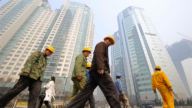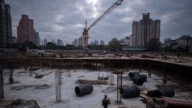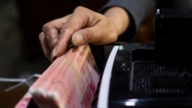【新唐人2014年08月12日讯】今年以来,大陆银行二级资本债发行规模已经突破千亿元,但几家银行又在近期再次发行高风险债务。业内认为,这表明大陆商业银行,已经拉开新一轮补血大幕来满足监管要求,以及防范经济下行压力资产质量恶化的风险,而其中房地产商资金断裂、放弃房产拒绝还款是主要原因。
8月8号,中国银行发行300亿元10年期固定利率二级资本债券,这是工商银行在4天前,发完600亿二级资本债计划中的200亿后,又一大型国有银行动作。
根据“中国货币网”信息统计,今年以来包括“兴业”、“民生”、“招商”、“华夏”等在内的多家银行,都已经发行二级资本债,从年初至今,二级资本债发行规模已经突破千亿元。
二级资本债风险高于普通债券,一旦发行人陷入困境并需要现金,或是监管机构判定发行人无法存续,债券购买者将损失全部投资。
大陆银行再次发行高风险债务。业内认为,这表明大陆商业银行,已经拉开新一轮补血大幕,来满足监管要求,以及防范经济下行压力资产质量恶化的风险。
旅美经济评论家马杰森:“中国前一段靠资本扩张催动GDP模式,使得银行业资金链很紧,而且资本运用效率很低,银行不得不不断从社会上集资,把银行的风险用债务的方式转嫁到社会上,让社会来承担一部分。”
业界认为,房地产商资金断裂、放弃房产拒绝还款,是银行再次发行高风险债务的主要原因。
今年由于房地产持续下滑,各地房地产老板跑路现象不断涌现。大陆《21世纪经济报导》日前报导,五、六月末,浙江杭州、江苏无锡、福建宁德、江苏新 沂等地,都有业主因个人按揭贷款逾期不能偿还,而被银行起诉的案例。这些案件中由于房产的现行总价低于贷款本息,业主大多声称“无力还款”。
而投资在中国房地产基金的外资,也因为受到损失而纷纷撤资。据美国《华尔街日报》报导,一批外国投资者,最近从一度估值高达10亿美元的一个中国房地产基金撤资,并蒙受了巨额损失。
马杰森:“这就是房地产在下走的时候,银行所必须承担的一个风险,这就是为什么银行系统开始充足自己的资金,以防类似这样的事情发生引发资金链更加紧的这样一个情况。”
中国金融智库研究院巩胜利:“中国以前36年来,把房地产看成了拉动中国经济的最大产业,占接近中国GDP的30%左右,使中国经济严重失衡。”
而中共印发了接近GDP两倍的钞票后,不仅引发了通货膨胀,也没能解决银行资金不足问题。“工商银行”除了计划发行600亿二级资本债券外,还将发行总额多达人民币800亿元的优先股。另外,“农业银行”和“建设银行”也在计划发行二级资本债券。
另外,目前中国银行业不良贷款也在迅速增长。大陆银监会7月25号公布数据显示,截至6月末,大陆商业银行不良贷款余额接近7000亿元。这个数据已经超过2013年全年。
评论指出,大陆银行业虽然在努力补充资本和加速处置不良贷款。不过,债务和银行不良贷款率的双双攀升,已经对中国经济构成双重风险。
采访编辑/刘惠 后制/钟元
Real Estate Market Downslides, Forcing Chinese Banks to Massively Issue High-risk Bonds
This year, Chinese banks have issued over 100 billion
yuan ($16 billion) of Tier 2 bonds.
Recently, several of them have again issued bonds
carrying high risks.
Economists say, the move suggests Chinese commercial
banks are running a new round of “blood transfusion”
to meet regulatory requirements and reduce risks of
deteriorating asset quality due to economic slowdown.
The main cause of the problem is that the breakdown of
capital chain of real estate developers, many of whom had
refused to pay their debts by abandoning the houses
they constructed.
On August 8, Bank of China (BOC) announced that
it would issue 30 billion yuan ($4.87 billion) of 10-year
Tier 2 bonds with fixed interest rate.
This is another move by major state-owned banks following
Industrial and Commercial Bank of China (ICBC),
which priced 20 billion yuan of Tier 2 bonds on Tuesday,
as part of its 60-billion yuan bond plan.
According to Chinamoney web, Industrial Bank,
China Minsheng Bank, China Merchants Bank, Hua Xia Bank
and many others have issued Tier 2 bonds in 2014.
Since the start of this year, Chinese banks have issued an
overall of over 100 billion yuan of Tier 2 bonds.
Tier 2 bonds carry higher risks than usual bonds.
Once issuers are trapped into cash shortage or regulators
recognize that issuers are not able to survive the duration
period, bond holders will lose all their investment.
Economists say, issuing high-risk bonds suggests
another round of “blood transfusion” moves
by Chinese commercial banks.
The purpose is to meet regulatory requirements and reduce
risks of deteriorating asset quality due to
economic slowdown.
Jason Ma, economic commentator:”The Chinese Communist
Party (CCP) had depended on the expansion of capital
to drive GDP growth.
This has cast great pressure on capital chain of banks,
along with a pretty low efficiency in capital use.
Therefore banks have to collect money from the whole
society by issuing bonds.
This partially transfers risks from banks to
the Chinese society.”
Economists comment that, Chinese banks are again issuing
high-risk bonds mostly because many real estate developers
had refused to pay their debts by abandoning
constructed houses, as the capital chain had broken down.
As China’s real estate market keeps sliding down, there have
been many reports of missing real estate entrepreneurs
after owning huge debts.
The 21st Century Business Herald reported that, in May
and June, there had been lawsuits filed by banks against
borrowers who failed to pay debts on time.
These cases were seen in Hangzhou, Wuxi, Ningde, Xinyi
and some other places.
As even properties’ total current price was lower than the due
amount to pay off, most property owners claimed that
“they were unable to pay loans and interests”.
Meanwhile, foreign capital involved in China’s real estate
market had also suffered loss and are retreating.
According to a Wall Street Journal report, “A group of
foreign investors suffered steep losses when it recently
exited a Chinese property fund once valued at $1 billion.”
Jason Ma:”As the real estate market declines, banks will
unavoidably take such risks on their shoulder.
This is why the CCP’s bank system starts to refill its fund
storage to guard against worse capital chain problems
resulting from similar incidents.”
Gong Shengli, researcher of China Finance Think Tank:”
In the past 36 years, the CCP has regarded the real estate
market as a leading driver of economic growth.
It contributes to about 30 percent of China’s GDP,
causing serious unbalance in China’s economy.”
The CCP had printed money amounting twice of annual GDP,
but still failed to solve the money shortage problem
at the cost of causing serious inflation.
ICBC now plans to issue 80 billion yuan ($12.9 billion)
of preferred shares, in addition to the plan of issuing
Tier 2 bond totaling 60 billion yuan.
The Agriculture Bank of China and China Construction Bank
are also making similar plans in issuing Tier 2 bonds.
China’s banking industry also sees a sharp increase in
the ratio of non-performing loans.
On July 25, China Banking Regulatory Commission
announced that by the end of June, Chinese commercial
banks have a balance of nearly 700 billion yuan
($114 billion) in bad loans.
The figure has exceeded that from the whole year of 2013.
Commentators say, Chinese banks are working hard to refill
capital pool and handle non-performing loans.
Despite that, China’s economy is still taking double risks
as both total debts and ratio of bad loans
are seeing sharp increase in magnitude.
Interview & Edit/LiuHui Post-Production/ZongYuan






























